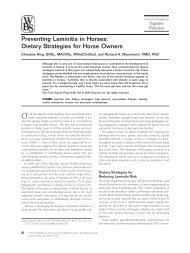Nutritional Secondary Hyperparathyroidism in the Horse
Nutritional Secondary Hyperparathyroidism in the Horse
Nutritional Secondary Hyperparathyroidism in the Horse
Create successful ePaper yourself
Turn your PDF publications into a flip-book with our unique Google optimized e-Paper software.
’The Nature of <strong>the</strong> Osteopathy 33<br />
The term “osteitis fibrosa” for <strong>the</strong> osseous lesions <strong>in</strong> nutritional<br />
secondary hyperparathyroidism <strong>in</strong> <strong>the</strong> horse was first used by JOST<br />
(1910). He gave a detailed description of <strong>the</strong> histologic changes <strong>in</strong> <strong>the</strong><br />
skull bones of a 6-year-old horse. He described all anatomical characteristics<br />
of osteitis fibrosa and presented several photomicrographs to<br />
support his diagnosis. JOEST and ZUMPE (1924) showed that o<strong>the</strong>r<br />
bones (cervical vertebra, humerus, femur) exhibit <strong>the</strong> same changes.<br />
The <strong>in</strong>vestigations by JOST and by JOEST and ZUMPE<br />
thus revealed that<br />
<strong>the</strong> osteopathy <strong>in</strong> bran disease is a generalized osteitis fibrosa. Never<strong>the</strong>less,<br />
<strong>the</strong> later literature does not show any uniformity <strong>in</strong> nomenclature.<br />
The disease cont<strong>in</strong>ued and cont<strong>in</strong>ues to be described as<br />



